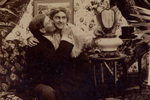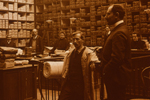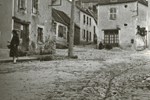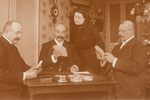Twice upon a time - Stereoscopy
 |
|
Lumière éteinte mise en scène vers 1896 |
The word stereoscopy derives from Greek ; stereo means solid and scope means vision.
In 1838, Charles Wheatstone discovered that it was possible to draw pictures giving an illusion of depth on a flat piece of paper. He named his discovery stereoscopy, a vision of the solid. The word aptly describes the sense of realistic depth perspective achieved by his technique. He had found what many before him had sought to master.
A sense of perspective can be achieved with just one eye, but 2 parallel eyes are needed to perceive depth and distinguish relative distances in space. This is the principle of human binocular vision, described in antiquity by thinkers such as Euclid. He noted that each eye has its own field of vision; the two separate images are merged by the brain to form a single picture.
Celui-ci constate que chaque oeil a sa vision et que les deux images séparées sont réunies par le cerveau pour n'en former plus qu'une seule.
 |
|
Cliché amateur, 1904 |
Leonardo da Vinci wrote of this phenomenon that the most accomplished painting, whatever the light, shadows and colour techniques employed, could never reproduce the true perspective of objects in nature. He noticed that each eye reveals a part of the scene which is hidden from the other eye; but Leonardo was unable to find a solution for representing objects three-dimensionally on a flat canvas.
Three centuries would pass before another genius, the Englishman Charles Wheatstone, discovered a way to represent three-dimensional images on a flat surface. In 1838 he published the results of his research in a paper entitled “Contributions to the physiology of vision”. Leonardo da Vinci, writes Wheatstone, did not take into account the fact that objects close to one another present a slightly different form when viewed by the left or the right eye. It was therefore necessary to reproduce, in parallel, the view of each eye. Wheatstone invented a device in which a play of mirrors allowed the two views to be merged, thus imitating our binocular vision. “I propose to call it a stereoscope”, said Wheatstone, “which is to indicate its property of representing solid figures”.
 |
|
Country scene, around 1900 |
At this same time, photography was invented virtually simultaneously by Daguerre in France and Talbot in England. David Brewster, a friend of Talbot, soon had the idea of applying the concept of stereoscopy as discovered by Wheatstone to photography. He designed a simple stereoscope using a box with two lenses into which one would slide the two parallel images. .
Unable to convince any optician in England to build his device, Brewster therefore travelled to Paris to work with the French optician Dubosq. These two together would produce a viewer for 3D photographs which they presented at the first universal exhibition in London in 1851. The fact that their device greatly impressed Queen Victoria ensured its immediate popularity with the general public.
Paris, in particular, inspired stereo photographers of the 19th century, and they delighted in representing the lively urban lifestyle in three dimensions. Photographers also travelled the world over, bringing exotic and realistic images back home to people who scarcely left their own neighbourhood.
 |
|
Culan in 1922 |
 |
|
Card players around 1900 |
By 1900, stereoscopy was no longer just an art form for professionals. Now amateurs could also buy double-lens cameras, and capture their world with enthusiasm, if not always with expertise. The authenticity of these scenes of people at work, home and play gives us precious insight into their lives.
The American Holmes created the most popular stereoscope. It was simple and inexpensive, and can still be found buried in attics the world over. Older people still remember these double pictures, glued together on cardboard, sold in packets.
Different techniques
Later, other techniques were developed to view pictures in 3D. Everyone recalls the glasses with a red filter over the left eye and a blue or green filter over the right. This forced each eye to see a slightly different and distinct image. This system was named anaglyph. But colours tended to be washed out. This is not the case with polarized lenses, which followed later.
Stereoscopy with polarized filters uses glasses with tinted lenses which look like sunglasses but are specially treated to separate right and left vision – again so that each eye sees a separate and distinct image.
The possibility of showing photos side by side on an internet site brought new methods. The Screenscope, developed by the Australian Paul Smargiassi uses mirrors and is very comfortable. However, in the absence of an inexpensive stereoscope, NVP3D decided in 2007 to create their own prism glasses, which sell for less than 10 euros, in order to encourage a wider potential public to discover 3D.
The future can already be glimpsed in the new auto-stereoscopic monitors, which permit 3D viewing without glasses. This technology is still in its infancy, and the monitors cost several thousand francs; also, one must be positioned at precisely the correct angle in order to perceive the depth effect. But this is definitely where we are heading before too long.